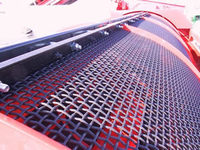Piano Wire Screen for Wet and Difficult Materials
Specifications
Piano Wire Screen - No Blinding and Plugging

Piano wire screen is an efficient screen with no blinding and plugging.
Piano wire screen is also called harp wire screen, non-blinding screen. It is made of high tensile spring wire, manganese steel wire and stainless steel wire. It is an efficient screen, which is installed on vibrating machines for sizing and separating the most wet, sticky, damp, dry and other difficult materials.
Piano wire screen elements, such as Material, number and placement of stripes, wire diameter and opening size can be customed to fit unique structures and applications.
Structure and operating principle
Piano wire is formed by longitudinal wires, which are embedded into a metal or plastic sliding bar to keep wires in place and maintain the opening size.
The long slots of the piano wire screen can be up to 12 inches, which can provide more area to increase screen efficiency.
Both sides of the end of piano wire screen have hooks, which can be C type hooks, U type hooks and V type hooks. This structure makes the screen be easy to installed on the machines.
They are base on the principle of the spring back of the single wires and on the property of a stretched wire to be put in oscillation with its own frequency.
Benefit of the polyurethane sliding bars
There are two types of sliding bars of the piano wire screen. Which is metal sliding bar and polyurethane sliding bar.
We recommend the polyurethane sliding bars. Wires embedded into flexible polyurethane strips instead of metal slide, which may cause breakage. The polyurethane strip piano wire screen can reduce the wear between steel wire and steel bars. It can keep the wires tensioned, creating better wire vibration and improve the wear life. Besides, it can reduce the blinding and increase production of aggregate product.
Specifications of the piano wire screen
- Material: High tensile spring steel wire and stainless steel wire.
- Sliding profiles: Polyurethane or metal.
- Wire diameter: 0.5mm - 8mm.
- Spacing of the wires: 1.2mm - 18mm.
- Length of the slot: Up to 12”.
- Hook type: C hooks, U hooks and V hooks.

Metal sliding bars of piano wire screen.

Polyurethane sliding bar of piano wire screen.
Features
- Simple. Made of several straight wires and no cross wires .
- Movable. Metal or polyurethane sliding profile can adjust the slot length.
- Accurate. The sliding profile can keep wires in place and ensure the opening size.
- Customed. Available in custom configuration to match unique screens and applications.
- Ease of installation. The different types of hooks makes it easy to install on different machines.
- Large open area. Long slot provide more open area to increase screen efficiency.
- High efficiency.
- Long service life.
- Wear and abrasion resistance.
- No blinding and plugging.
Applications
Piano wire screen is a exceptionally high tensile screen type. It is used on a range of fine materials, that are unsuitable for larger square mesh screens, such as sand, topsoil, peat and other similar products.
Piano wire screen is ideal for sizing and separating the wet, sticky, damp, dry abrasive and other materials.

Piano wire screen can be used for separating sand, topsoil and other materials.

Piano wire screen is ideal for separating the wet material with no blinding and plugging.
- Country: Afghanistan
- Market: Americas,Asia,Emerging Markets,Europe,G20,Middle East,Africa
- Address: Industrial Park, Anping County, Hengshui City, Hebei Province, China
- Contact: hui zhang










